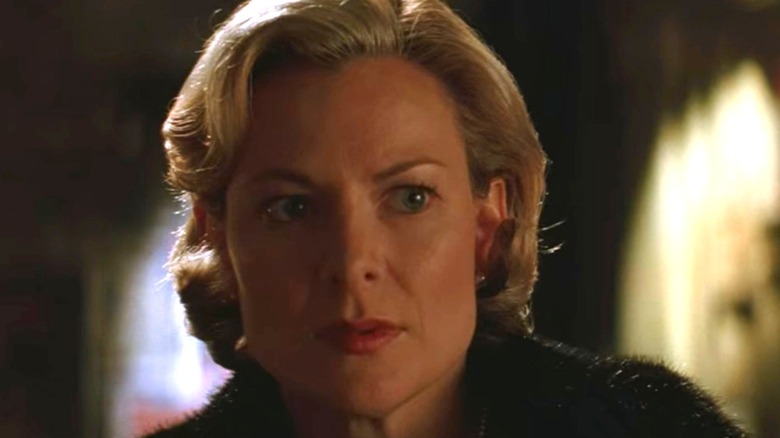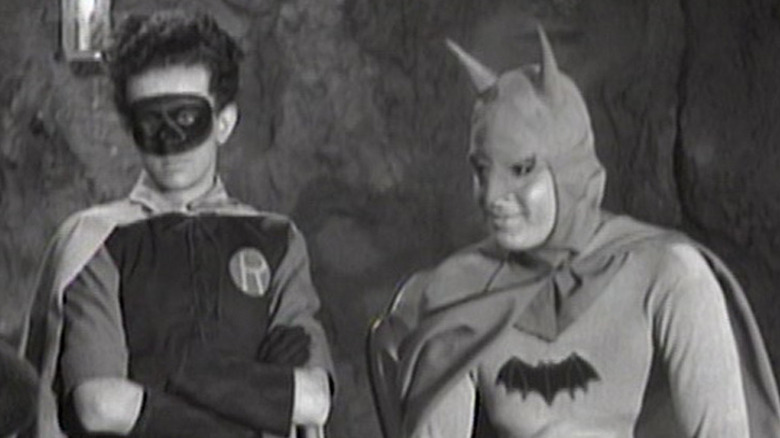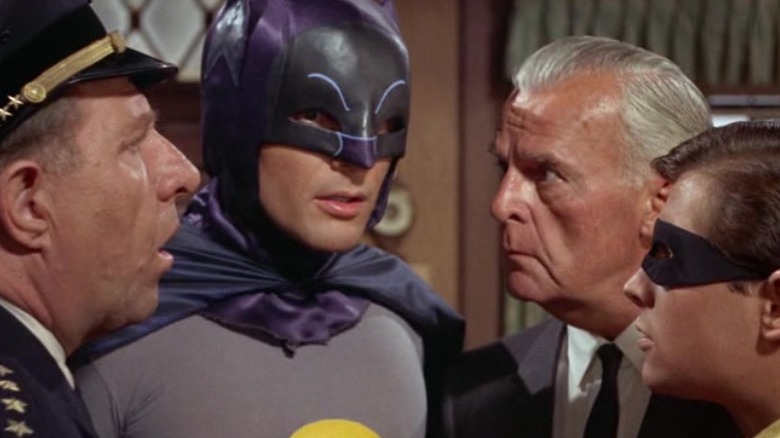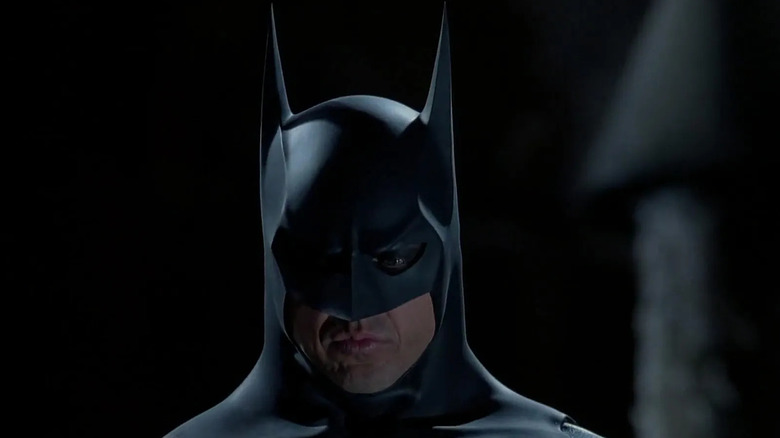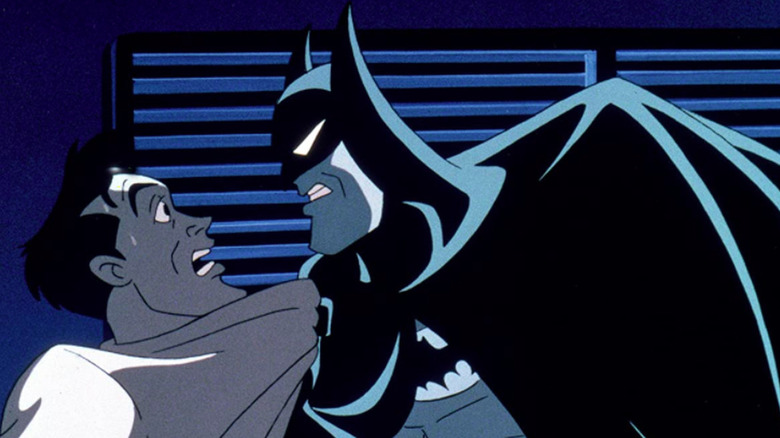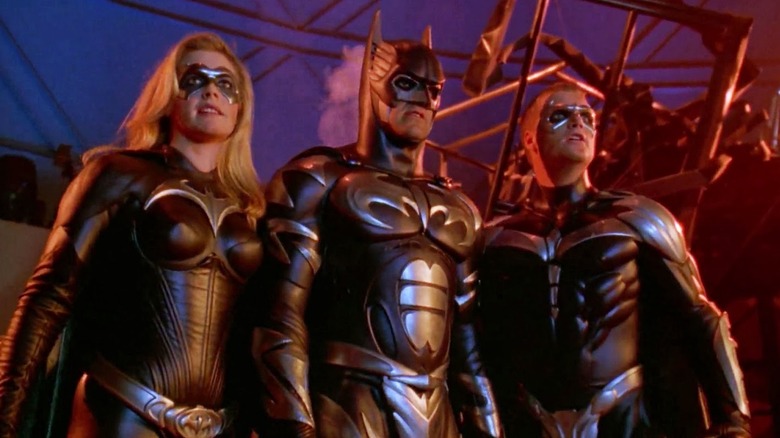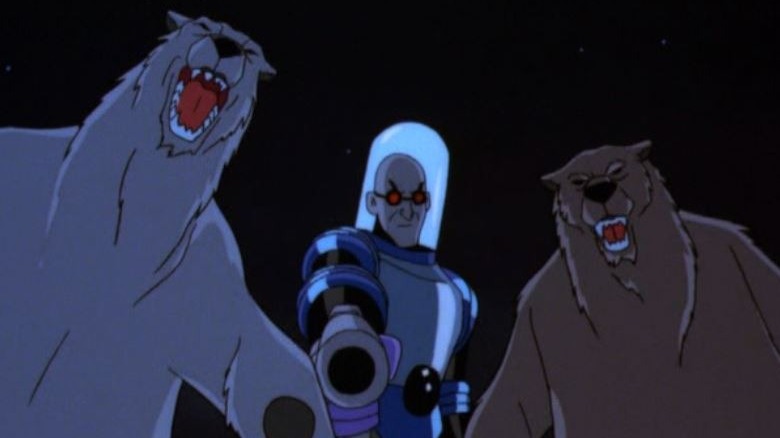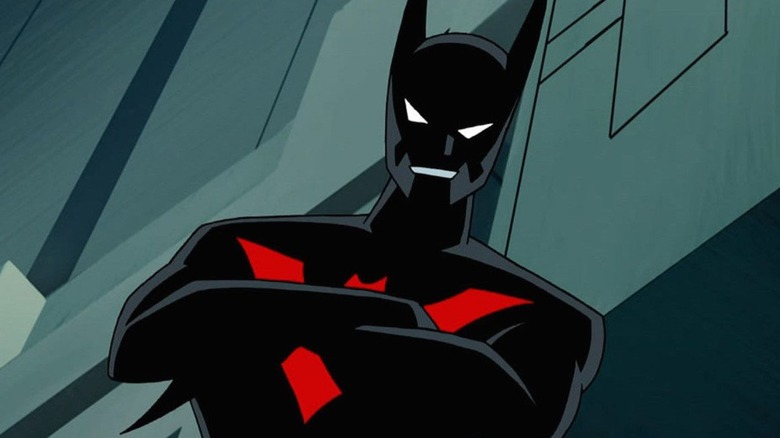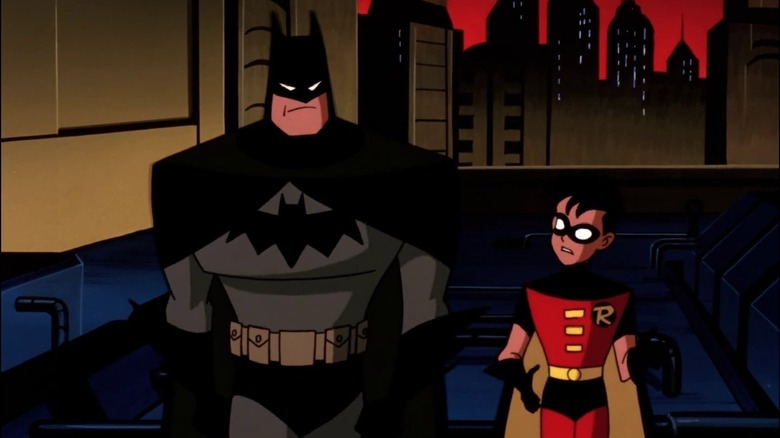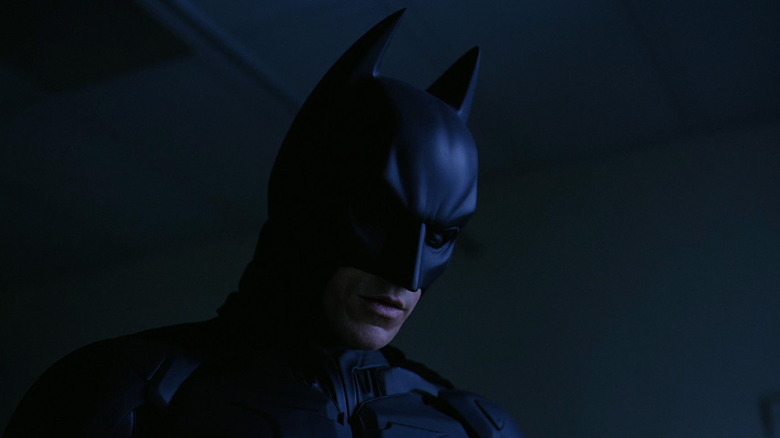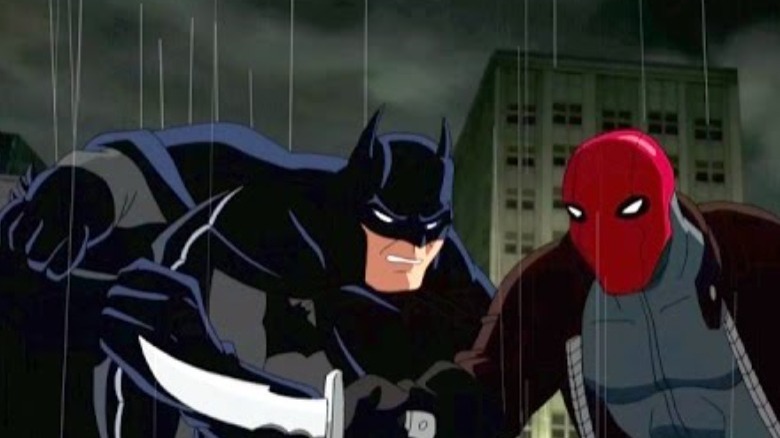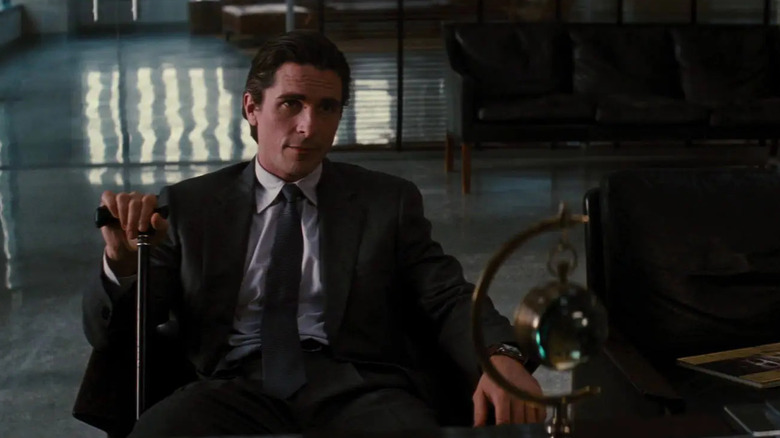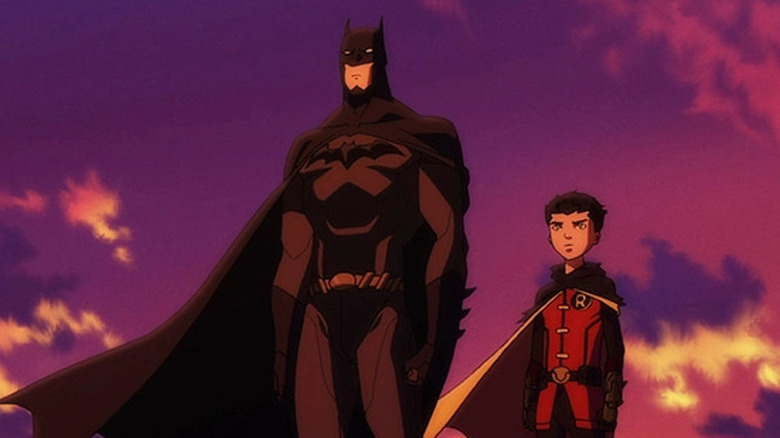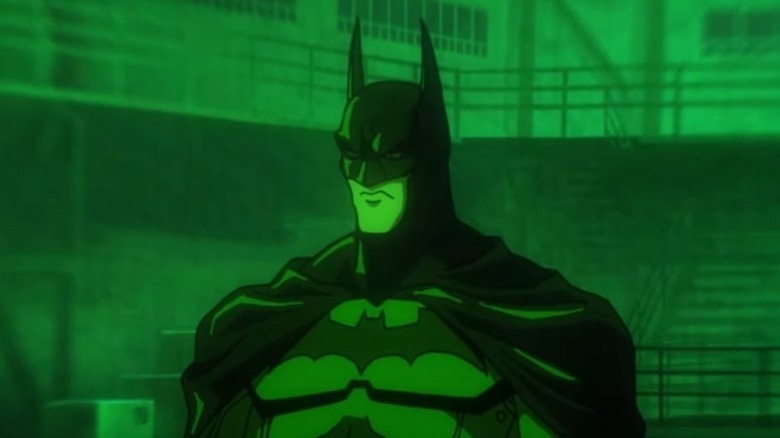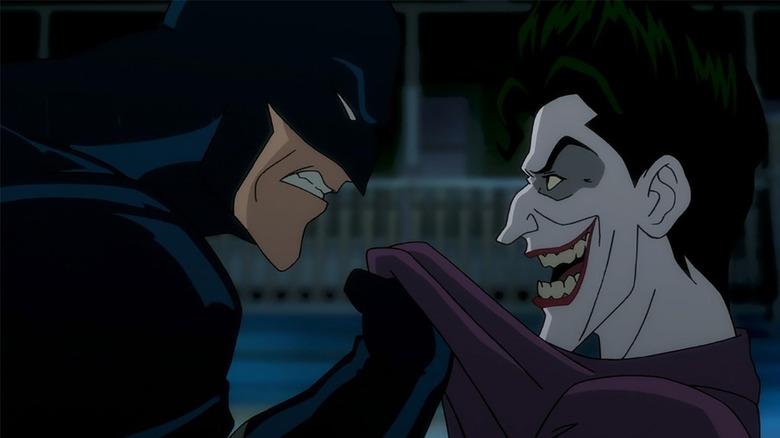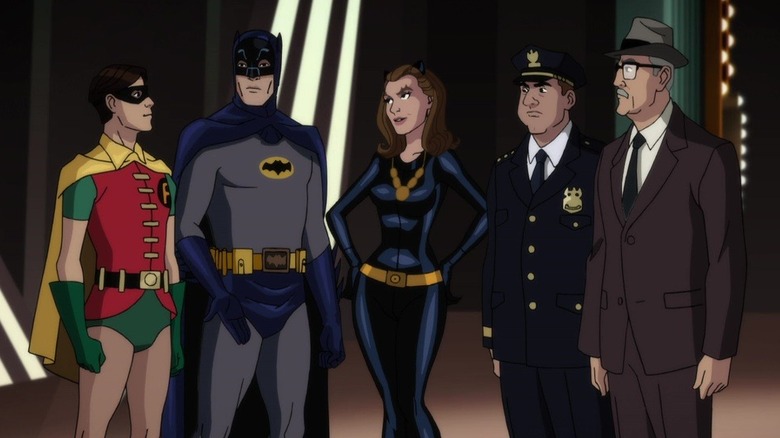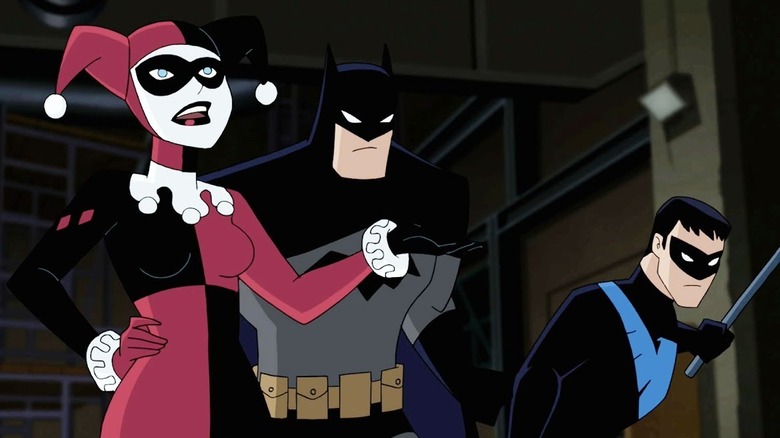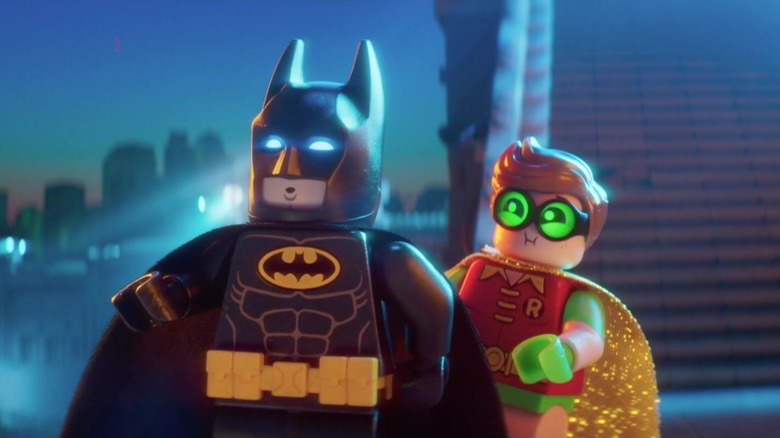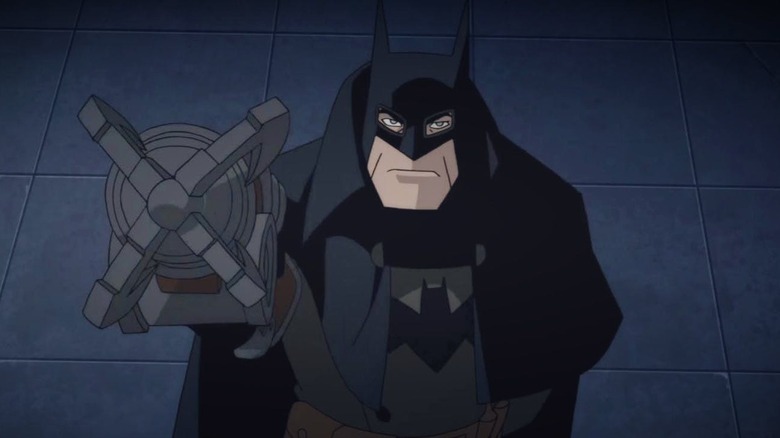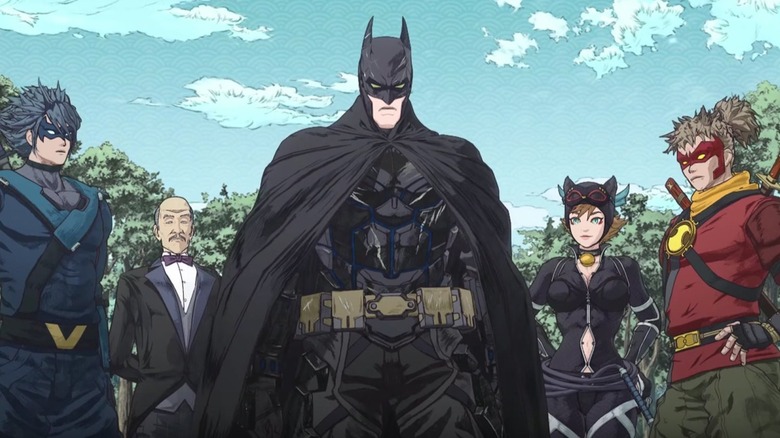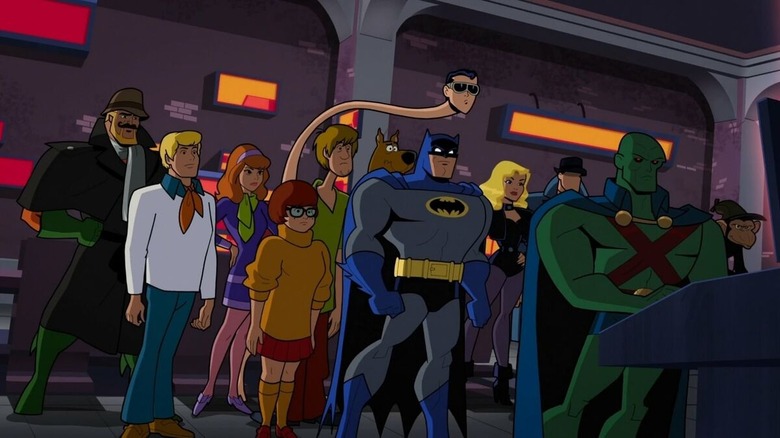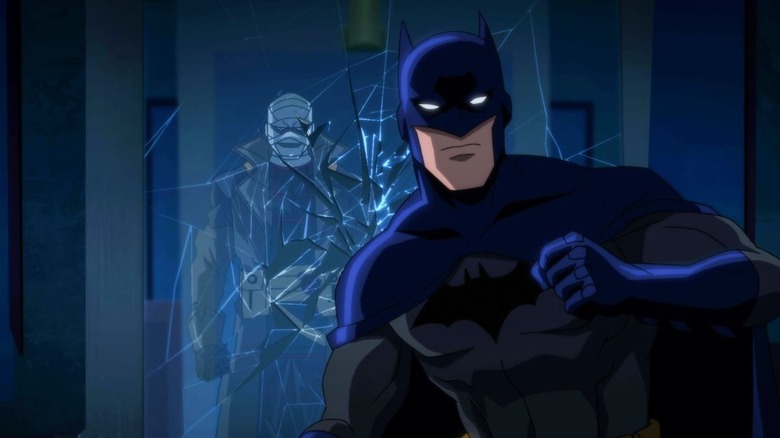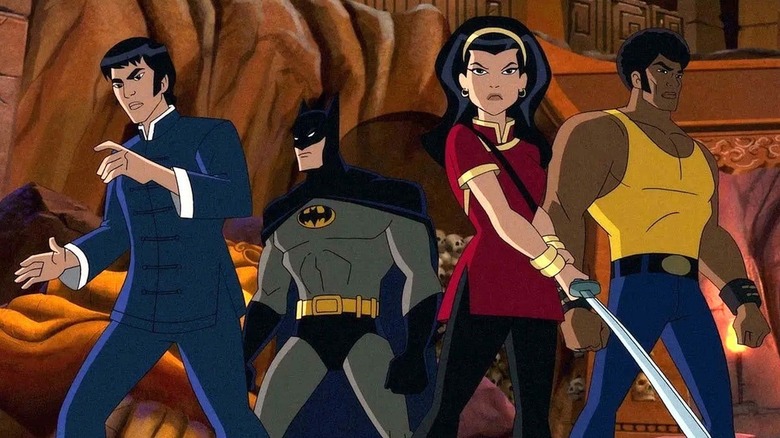The Only Batman Movies Or TV Shows That Didn't Show His Parents Dying
Over the many decades since his 1939 debut, Batman's origins have become about as well known as the Pledge of Allegiance in the United States. After his parents were murdered in front of him, Bruce Wayne decided to train his mind and body to become an avenger of the night, playing off the fears and superstitions of criminals, both human and super.
Martha and Thomas, Bruce's parents, are significant players in the creation of Batman, maybe the most crucial aside from the killer himself. You can probably picture some version of the family leaving a show, then walking through a dark alley where a thief appears and wants their valuables. There's a struggle, pearls often spill out across the grimy street, and a child is left forever scarred. If we do not see the scene in real-time, we're often witness it through Bruce Wayne's memories or dreams — usually while he's sitting in a leather chair in a darkened study.
You can picture it because you've seen it so many times portrayed on screens large and small over the decades. However, "The Batman" director Matt Reeves decided not to include that scene, even though their deaths play into the story more so than many others. It's far from the first time that viewers haven't had to bear witness to such horrible acts. Here are the other live-action and animated shows and movies that also avoided showing the Dark Knight's darkest night.
The Batman Serials
The Dark Knight's big-screen debut came way back in 1943 in a 15-part serial starring Lewis Wilson as Batman and Douglas Croft as Robin. Debuting just a few years after the character's 1939 debut, "Batman" came out to theaters episodically each week. They would run along with newsreels and cartoons before the features.
Very much of its time, this serial paints the Dynamic Duo as agents of the United States government trying to stop Japanese terrorist Dr. Tito Daka from using his disintegration ray to destabilize Gotham. While TCM notes that the story includes racist portrayals of Japanese people, it also introduces many classic "Batman" story elements. Our heroes encounter kidnapped scientists, a lab hidden in an amusement park, mind-control weapons, brawls, car chases, literal cliffhangers, and the serial also sees the debut of the Bat's Cave. However, it does not dig into our hero's origins whatsoever.
"Batman" proved successful enough that the studio released a follow-up called "Batman & Robin" in 1949, this time with Robert Lowery and Johnny Duncan in the lead roles. Over the course of the 15 parter, the heroes do their best to track down The Wizard and his machine that could take over and remotely control cars by harnessing the power of diamonds!
Batman '66
Between the delightful movie and the TV series, both of which debuted in 1966, "Batman" did not delve deeply into the man behind the mask. Sure we saw Bruce Wayne and Dick Grayson as portrayed by Adam West and Burt Ward, but aside from a never-wavering sense of right and wrong, Bruce's reasons for becoming a masked hero remained a mystery.
In an all-around way, the 1960s series — dubbed "Batman '66" by fans — kept things light. From the bright colors and the rotating fight sound effects, some consider it silly and campy, which is fair, but it was also the prominent take on Batman for years. While things would get dramatic for a beat here and there, there just wasn't the space to interject a scene of young Bruce witnessing his parents' death. How would that have looked between episodes featuring Bats in swim trunks over his costume or doing the Batusi?
After "Batman" went off the air in 1968, West continued portraying the character. He and Ward appeared in costume for the two 1979 live-action "Legends of the Superheroes" specials, "The Roast" and "The Challenge." West also voiced him in animated offerings like "Super Friends" which ran from 1973 through 1986 under a variety of title shifts. In a bit of history that might stun many, Den of Geek notes that the very first time Bruce's origin was conveyed on a TV series came about in a version of "Super Friends" — specifically in a 1985 "The Super Powers Team: Galactic Guardians" episode called "The Fear."
Batman Returns
It might not seem like it today, but Tim Burton had his work cut out for him when he signed on to direct "Batman." Even though it had been off the air for decades, the '60s "Batman" series was still the version of the Caped Crusader that most people were familiar with outside of the comics. As such, he included the deaths of Thomas and Martha Wayne as a flashback in the 1989 film to help establish a new tone. From there, he crafted a dark yet fantastical film starring Michael Keaton as Batman and Jack Nicholson as the Joker that many still consider a classic.
However, in his follow-up, 1992's "Batman Returns," Burton did not feature Bruce Wayne's doomed parents. If you watch the film, you'll notice that Bruce's history takes a back seat to an exploration of the origins of villains like Penguin (Danny DeVito), Catwoman (Michelle Pfeiffer), and Max Shreck (Christopher Walken). When it comes to flashbacks about childhood trauma, Oswald "Penguin" Cobblepot winds up getting the most attention, as the film begins with a look at his monstrous birth and shows his parents tossing the child off of a bridge right before Christmas!
Batman: Mask of the Phantasm
Though not shown explicitly, the Waynes' deaths play prominently into the 1993 animated feature "Batman: Mask of the Phantasm." During these post-death, pre-Batman days, Bruce (Kevin Conroy) begins a relationship with a young woman named Andrea Beaumont (Dana Delany). After she leaves him, Bruce fully dedicates himself to becoming Batman. This relationship comes back to mind in the present when Andrea returns to town around the same time as a new, deadly vigilante by the name of Phantasm.
This film is a direct spin-off of "Batman: The Animated Series," which debuted in 1992 and established the world seen in "Superman: The Animated Series," "The New Batman Adventures," "Batman Beyond," "Justice League," and "Justice League Unlimited." A variety of episodes deal with the death of his parents, often handled so as not to scar younger viewers too much. In "Appointment in Crime Alley," Batman looks through some news clipping about his parents' murder. While incapacitated once more by the Scarecrow, the Dark Knight dreams of trying to stop his parents from dying, but the entire environment turns into a giant gun. "The Strange Secret of Bruce Wayne" also shows a nightmarish representation of their murders involving a dark alley turning into a giant gun.
It was to this already established world that "Batman: Mask of the Phantasm" plays out. With much of the groundwork there, this film is able to show more of the Caped Crusader's origins that lead him directly into the cape and cowl.
Batman & Robin
After "Batman Returns," Tim Burton and Michael Keaton left the franchise, but Warner Bros. still wanted to make more flicks — so they hired Joel Schumacher to do exactly that. In his first offering, 1995's "Batman Forever," Val Kilmer's Bruce Wayne remembers a quick snapshot of his parents' murder along with flashbacks to the time immediately after their deaths, when he discovered the future site of the Batcave.
With the second installment in Schumacher's two-part Bat series, though, you don't get much in the way of the Waynes. The story in 1997's "Batman & Robin" spends a great deal of time focusing on the machinations of Arnold Schwarzenegger's Mr. Freeze and Uma Thurman's Poison Ivy, as well as the news that loyal butler Alfred Pennyworth (Michael Gough) is at death's door. As such, Bruce — now played by George Clooney — thinks back to how well the man took care of him after the deaths of his parents.
In fact, the story attempts to put some of the emotional weight of the film on Schwarzenegger, whose character is motivated, at least partially, by the desire to save his wife Nora's life. That doesn't exactly explain why he tries to put the entire city on ice or speak in puns the whole time – but we all process trauma differently.
Batman & Mr. Freeze: Subzero
Over the course of the iconic "Batman: The Animated Series" run, the creatives pulled off several impressive feats, but one of the best was how they handled Mr. Freeze as a tragic figure. All Victor Fries wanted out of life was to use his scientific acumen to save the life of his beloved wife, Nora. Paul Dini and Bruce Timm set all of that up in the episode "Heart of Ice," which debuted in 1992.
Voiced by Michael Ansara, Mr. Freeze became such a fan favorite that he came to star in a straight-to-video release in 1998 called "Batman & Mr. Freeze: Subzero." With the relatively short run time of 70 minutes and the fact that this is clearly set in the "Batman: The Animated Series" continuity, the movie does not take the time to recap the Dark Knight's origins. Instead, it focuses on Fries' attempts to kidnap Barbara Gordon (Mary Kay Bergman) in an effort to save Nora and the lengths that Batman and Robin (Loren Lester) go to save her. Though initially scheduled to come out in the summer of 1997 to support "Batman & Robin" — you'll notice that both films feature similar characters — Variety reported that the animated one was ultimately delayed when the live-action did not perform as well as expected.
The result is a flick that does include some bad CGI but also a dramatic story featuring one of the franchise's most compelling villains as well as polar bears, oil rigs, and swing dancing — all depicted in that trademark "Batman: The Animated Series" style.
Batman Beyond
In 1999, Warner Bros. launched a "Batman: The Animated Series" spinoff called "Batman Beyond." Set two decades later, this series finds a retired Bruce Wayne (Conroy) hiding out in Wayne Manor. That is, until teen Terry McGinnis (Will Friedle) discovers the truth and becomes the new Batman with the help of a high-tech suit. Though Martha and Thomas are mentioned in the series, their deaths are not the main source of conflict. In fact, this Wayne has experienced so much trauma in his long life that his parents' deaths act as just the first step on a very sad ladder.
However, Terry's story runs parallel to Bruce's in other ways aside from his bravery and desire to hunt down criminals. His father was killed the same night that he had his first run-in with the Jokerz gang and met Wayne. The series received a straight-to-video feature film in the form of "Batman Beyond: Return Of The Joker" in 2000.
In "Batman Beyond: Return Of The Joker," a straight-to-video offering, Mark Hamill returned to voice the Joker, who now controls a gang of super-criminals and even manages to take Wayne out for a time. Still, Terry perseveres, using his detective skills to suss out what happened to the arch-fiend and how it tragically relates to the last time Tim Drake (Dean Stockwell) went out as Robin. This film shows just how much a person like Bruce Wayne can take without breaking.
New Batman Adventures
After running for five years as "Batman: The Animated Series," the show received something of an update in 1997, becoming "The New Batman Adventures." Though set in the same world and continuity, the characters took on a new look, and these stories are set a few years later than the ones in the original. As such, you have Batman (Conroy) and Batgirl (Tara Strong), but Dick Grayson (Lester) has graduated to become Nightwing and Tim Drake is a younger Robin (Mathew Valencia). Throughout this version, Thomas and Martha are mentioned, but their deaths are not shown.
That carries on into the straight-to-video film "Batman: Mystery Of The Batwoman." In this one, a masked vigilante going by Batwoman (Kyra Sedgwick) makes her presence felt in Gotham, however, even Batman doesn't know who she is at first. He's also not thrilled with her more destructive, less law-abiding methods. A full-on action/mystery, "Batman: Mystery Of The Batwoman" does not delve into Bruce's sadder days and, in fact, shows him actually enjoying the company of a woman outside his cape and cowl.
The Dark Knight
Not unlike Burton before him, Christopher Nolan worked hard to bring the Caped Crusader (Christian Bale) back to a more serious place in theaters with the release of "Batman Begins" in 2005. That film features a flashback to Thomas and Martha's murders after a family trip to the opera is cut short by a frightened Bruce. From there, we see Christian Bale as a Bruce Wayne figuring out what to do with his anger as he learns what it will take to become a force for justice. Along the way, he encounters the League of Assassins, Ra's al Ghul, and the Scarecrow.
Using the foundation established by the first film, 2008's "The Dark Knight" builds on that without rehashing that particular plot point, instead focusing on the chaos brought about by the Joker (Heath Ledger) and Harvey "Two-Face" Dent (Aaron Eckhart). Throughout the film, it's Joker who recounts several potential origins for himself, though it's impossible to know which, if any, are true. Ultimately the hero saves the day but agrees to let Commissioner Gordon (Gary Oldman) pin Dent's death on the masked man.
Batman: Under The Red Hood
The first attempt by the Warner Bros. DC Animated team to translate an existing solo Batman story came in 2010 when they presented "Batman: Under the Red Hood." The previous Batman film put out in the DC Universe Animated Original Movies series, 2008's "Batman: Gotham Knight," featured an original anthology treatment that did include a flashback to the murder of Thomas and Martha. "Batman: Under the Red Hood," though, is based on the story by Judd Winick and Doug Mahnke starting in "Batman" #635.
In this tale, a new crime boss calls himself Red Hood (Jensen Ackles), an old alias of the Joker. As you might expect, this is a move that draws the attention of the real Clown Prince of Crime (John DiMaggio) as well as Batman (Bruce Greenwood), not to mention crime lord Black Mask (Wade Williams). As Gotham witnesses another bloody war for territory, the Dark Knight finds himself reeling at the identity of the person under the mask.
"Under the Red Hood" begins with a heartbreaking flashback and mixes in a variety of others that set the stage for the drama at hand. The identity of the new criminal will be well-known to comic fans, but we're hoping newcomers will be equally stunned when they see the reveal. One thing that you won't see, though, is a recounting of the infamous origins! This Batman has already been through more tragedy than the boy in the alley could imagine.
The Dark Knight Rises
After the events of "The Dark Knight," Batman hung up the cowl for about eight years. During that time, Harvey Dent becomes a shining example of goodness and a paragon of virtue put on a pedestal to drive organized crime out of Gotham — even though he attempted to kill Gordon's son. At the beginning of 2012's "The Dark Knight Rises," Bruce Wayne is mostly holed up in his mansion refusing to see anyone until the day that Selina Kyle (Anne Hathaway) breaks in, copies his fingerprints, and swipes the pearl necklace that once belonged to Martha Wayne.
A mysterious new player with ties to Batman's past, Bane (Thomas Hardy), starts making moves, forcing the hero to put the cape and cowl back on and get to work. However, he's soon shown to be the less prepared of the two and must find a way out of the literal and mental hole he finds himself in. While the feature does not include a scene depicting the Waynes' deaths, their specters loom large over the film. We also see a parallel with one of the film's villains, who also lost a mother to horrible violence.
Son of Batman
In the past few decades, Batman's fans have encountered many stunning surprises. You can see one of them in "Under the Red Hood," but another came when Grant Morrison wrote "Batman" #655 and immediately revealed that he had an unknown son with Talia al Ghul, the daughter of his enemy Ra's al Ghul. Since then, Damian Wayne has not only become Robin but a major player in Batman's life and Gotham as a whole.
The 2014 animated feature "Son of Batman" takes inspiration from that story, introducing Damian (Stuart Allan) to his father (Jason O'Mara) and viewers at the same time. He's dead-set on avenging the death of his grandfather (Giancarlo Esposito) at the hands of Deathstroke (Thomas Gibson) but finds that his father does not share his methodology. More of the boy's origin story than his dad's, "Son of Batman" is about balancing the ideas of revenge and redemption and seeing which one ultimately works best.
In the 2015 follow-up, "Batman vs. Robin," the Dark Knight finds himself faced with a secret organization called the Court of Owls. He then remembers a story that his father Thomas (Kevin Conroy) told him when he was a boy about that very organization and the Talon agent they would send after those they considered threats. He then flashes directly to the deaths of his parents and wonders if there might be a connection.
Batman: Assault on Arkham
Though he gets title billing in this 2014 animated feature, "Batman: Assault On Arkham" features the Caped Crusader (Conroy) teaming up with the Suicide Squad. Here, Amanda Waller (CCH Pounder) brings together a group of criminals, which includes Harley Quinn (Hynden Walch), Deadshot (Neal McDonough), Captain Boomerang (Greg Ellis), and King Shark (John DiMaggio) to break into the famous asylum. Once there, they must steal a potentially earth-shattering device formerly belonging to the Riddler (Matthew Gray Gubler). This was two years before the original "Suicide Squad" movie came out, so maybe the powers that be weren't sure that title would have much cache.
Anyway, Batman soon gets involved, first during a brief fight with Harley and later when he realizes something's up at Arkham. The op goes sideways, as you might expect, with the Joker (Troy Baker) getting loose and the hero getting more involved. As you might expect with an ensemble cast like this, there isn't much time for anyone's origins, especially the Bat's. So, while this offering does not shy away from murder, it also doesn't feel the need to darken the proceedings further with even a mention of Martha and Thomas' deaths. The same goes for the Ben Affleck Batman cameo in the 2016 "Suicide Squad" flick!
Batman: The Killing Joke
In 2016, fans finally got what they'd been asking to see for years in an adaptation of Alan Moore and Brian Bolland's seminal 1988 graphic novel, "Batman: The Killing Joke." This, along with Frank Miller's "Batman: Year One" and "The Dark Knight Returns" from the same era, ushered the Caped Crusader down much darker alleys than even the one his parents were killed in. The first half-hour of this R-rated film showcases Barbara "Batgirl" Gordon (Tara Strong) and the frustrations she feels as a hero. After that, it turns into a fairly faithful adaptation of the graphic novel that features the Joker shooting Barbara Gordon and torturing her father Jim (Ray Wise) before Batman can track him down.
From the unexpected sex scene to the harrowing acts committed by the clown and an ending that leaves you wondering exactly how dark the Dark Knight will allow himself to get, "Killing Joke" captures the source material's tone while expanding on it at the same time. While we don't see Batman's origins, we do see one version of the Joker's as we follow a down-on-his-luck comedian who gets tied into the mob around the same time his pregnant wife dies. During the climactic confrontation between the arch-rivals, Joker asks Batman how far away any normal person might be from becoming a crazed killer. It's an interesting question, but also one that is somewhat answered by Batman's own beginnings that night in the alley. Both men suffer incredible tragedy but handle it in very different ways.
Batman: Return of the Caped Crusader
The same year that the super-dark "Killing Joke" came out, WB and DC also released its polar opposite: "Batman: Return of the Caped Crusader." This offering stands out because it's set in the world of the '60s TV series and even features Adam West, Burt Ward, and Julie Newmar returning to portray Batman, Robin, and Catwoman, respectively, something that never would have worked in live-action. Here, Catwoman teams up with Joker (Jeff Bergman), Penguin (William Salyers), and Riddler (Wally Wingert) — just as she did in the 1966 "Batman" film — to once more wreak havoc on Gotham.
In addition to celebrating the living talent behind the seminal series, "Caped Crusaders" was also part of the push to get "Batman '66" back into the public consciousness. For years, the episodes could be seen on various vintage TV networks but not purchased for home viewing. The Hollywood Reporter revealed that this had finally all changed in 2014 when rights issues were cleared up and fans got a flood of merch from the show — and a new comic series aptly titled "Batman '66."
The following year saw the release of a sequel featuring a classic villain who never appeared in the original series with "Batman vs. Two-Face." Newmar's fellow Catwoman actress Lee Meriwether got involved, as did William Shatner, who played the villain in what would prove to be West's final appearance as the Dark Knight. Carrying on the tradition established in the TV series, neither film addressed Bruce's parents' deaths and also up the action quotient given the unlimited special effects budget that comes with animation!
Batman and Harley Quinn
With the release of "Batman & Harley Quinn" in 2017, the animated team returned to a beloved well: the one that actually saw the debut of Miss Quinzel several decades prior, the one established by Bruce Timm, Paul Dini, et al in "Batman: The Animated Series." In the film, Batman and Nightwing need Harley Quinn's help to stop her old pal Poison Ivy from destroying the world along with fellow plant-based villain, the Floronic Man.
Featuring classic voice talent like Kevin Conroy as Batman and Loren Lester as Dick Grayson alongside Melissa Rauch and Paget Brewster jumping in as Harley and Ivy, the new tale mixes in some of the campier elements of the '60s Batman TV show — yes, there are fart jokes — but also more adult drama and bawdier gags than you might expect. With that lighter tone and the established world being inhabited, the story did not call for such a serious moment as recounting the Waynes' deaths.
The Lego Batman Movie
To say that Batman's more recent big-screen appearances have been divisive is like saying his Rogue's Gallery might be a bit unstable. However, there is one film that just about everyone loves, and that's 2017's "The Lego Batman Movie," which itself spun out of "The Lego Movie." In the film, Will Arnett plays the lead character who, unlike most other portrayals, comes off as a raging egomaniac with little room for others in his life. However, this take does actually get at one of the most important aspects of the Dark Knight's character: his desire to build a new family from the wreckage of his previous one.
That becomes all the more evident as the film progresses when he adds not just Robin (Michael Cera) to his crime-fighting crew but also Alfred (Ralph Fiennes) and Barbara Gordon (Rosario Dawson). Even though this version does not show the moment of his parents' demise, they still loom large in Bruce's life. In fact, when he's at his most emotional, he's often staring at a selfie taken on what might have been the night they were killed, as they appear to be outside a theater.
Batman: Gotham by Gaslight
Set in an alternate reality, "Batman: Gotham by Gaslight" from 2018 brings Jack the Ripper to Victorian Gotham. Luckily for some of the townspeople, they have their own version of Batman (Bruce Greenwood) watching over them as well as a formidable Selina Kyle (Jennifer Carpenter) looking out for the women being murdered by the mysterious killer.
Interestingly, the comic book from which the story takes its title, design, and basic story elements opens with a new version of the Dark Knight's origin story. Bruce and his parents are riding along in a carriage at night when they are held up by a man with two revolvers who uses them to kill his parents. Taking advantage of the timing of this out-of-continuity tale, creators Brian Augustyn and Mike Mignola have Wayne not only haunted by the murders in his dreams but explaining this very thing to none other than Sigmund Freud.
Though more fleshed out than the 1989 comic story, the film skips over Batman's origin and quickly becomes a thriller with just the slightest hint of steampunk. The story even mixes in a World's Fair, not unlike the real-life Chicago-based one featured in Erik Larsen's "The Devil in the White City," which producer Bruce Tamm cited as an influence, all while telling a unique, new tale that will keep you guessing!
Batman Ninja
When it comes to versatility, most heroes don't hold a candle to Batman. As we've seen, he can be everything from hilarious to just about the darkest dude around. He can also operate in contemporary settings — which have changed quite a bit over the decades — or be worked into a unique world designed by visionary creators, as we saw in Tim Burton's films, "Batman: The Animated Series," and beyond. "Batman Ninja" deftly shows that he can work just as well back in time!
In this 2018 offering, Bats (Roger Craig Smith) works to stop Gorilla Grodd (Fred Tatasciore) from demonstrating the time-bending Quake Engine at Arkham Asylum. When he fails, the heroes and villains are sent back in time and space to feudal Japan. The freed rogues set about establishing their own seats of power in the surrounding states. However, the Dark Knight himself arrived a full two years after the rest. While trying to get his bearings, Bats reunites with Catwoman (Grey Griffin), Alfred (Adam Croasdell), Nightwing (Croasdell), Robin (Yuri Lowenthal), Red Robin (Will Friedle), and Red Hood (Lowenthal).
While this feature does not include direct references to the deaths of Thomas and Martha, it is, at its heart, about family. Upon arriving, Batman feels at a loss because his access to tech and gadgets is limited. He even allies himself with a villain, only to find himself betrayed. Ultimately, the Caped Crusader decides to embrace not only the place and its surrounding resources but also the family he has built himself by way of his partners.
Scooby-Doo! & Batman: The Brave and the Bold
"Batman '66" might get the most love when it comes to takes on Batman that have a bit of a lighter edge to them, but there's another that beautifully carried on that tradition, and that's "Batman: The Brave and the Bold," an animated series that ran from 2008 until 2011. Unlike its more fun and fancy-free predecessor, "Batman: The Brave and the Bold" did, in fact, directly address the murder of Martha and Thomas in an episode called "Invasion of the Secret Santas." Around the holiday season, Bruce (Diedrich Bader) remembers being a jerk to his parents, who took him to the movies after he didn't like his Christmas present. They were killed on the way home. We see a darkened alley with muzzle flashes and him crying, "Mom! Dad!"
A decade after the series began, the creators carried on another tradition by teaming the Caped Crusader up with those Mystery Machine-driving sleuths in "Scooby-Doo! & Batman: The Brave and the Bold." Batman and his associates appeared in a handful of "Scooby-Doo!" episodes to the delight of fans everywhere. This time around, the Caped Crusader brought the kids into a group called Mystery Analysts of Gotham that also included Martian Manhunter (Nicholas Guest), Detective Chimp (Kevin Michael Richardson), Black Canary (Grey Griffin), Plastic Man (Tom Kenny), The Question (Jeffrey Combs), and Aquaman (John DiMaggio). The film forgoes anything in the way of dark origins to bring out just about every Bat villain you can think of as they try to solve the mystery of the spectral Crimson Cloak.
Batman: Hush
Over the years, writer Jeph Loeb has made a name for himself by creating blockbuster-style stories featuring comics' most famous characters encountering the majority of their rogues all in one tale, often while teaming up with the best artists around. He did it with "The Long Halloween" — which was adapted into a two-part animated feature that does include a Scarecrow induced remembrance of the Waynes' murders — and again with "Hush." Originally appearing in "Batman" #608-619 with art by all-time legend Jim Lee, this yarn finds the Dark Knight (O'Mara) trying to figure out the identity of the title villain.
As with the source material, Batman encounters most of his famous villains and allies, but it does take some detours when it comes to who is behind the whole thing. Some of those changes come as a result of this "Hush" being a part of the DC Animated Movie Universe, which includes other Bat titles like "Son Of Batman," but also "Flashpoint," "Justice League War," and "Reign Of The Supermen." The film focuses more on the budding relationship between Batman and Catwoman (Jennifer Morrison) over Bruce's past with his childhood.
Batman vs. The Teenage Mutant Ninja Turtles
Usually, when dealing with a crossover like "Batman vs. The Teenage Mutant Ninja Turtles," you'd expect the origins of both parties to get told, just in case the audience isn't familiar with them. However, in the case of this fun flick based on the 2015 "Batman/Teenage Mutant Ninja Turtles" limited series by James Tynion IV and Freddie Williams II, you don't get any origin recaps! In fact, unlike the comic, which finds the two worlds crashing together from different dimensions, the film version simply finds the New York-based Turtles traveling to Gotham to find out what Shredder (Andrew Kishino) and the Foot Clan are doing with Ra's al Ghul (Cas Anvar) and the League of Assassins!
By not getting into the dark reasons why Batman (Troy Baker) does what he does, this film allows the hero to have a lighter adventure that could have easily ended with him borrowing Splinter's line, "I made a funny." As you might expect, there are also a number of awesome fight scenes between Batman and Shredder, Leonardo (Eric Bauza), and Ra's al Ghul – not to mention all of Batman's rogues who have all been turned into human-animal hybrids!
Batman: Soul of the Dragon
In 2021, DC and WB released yet another film that shows how Batman's mythology can be transposed backward in time onto genres from bygone eras. In "Batman: Soul Of The Dragon," we find Gotham's Guardian (David Giuntoli) protecting his city as usual, but this time we're set firmly in the 1970s. Not the real version of the decade, but the kind seen in kung-fu flicks made popular by Bruce Lee. Here, we flashback to a time when Bruce Wayne traveled to the city of Nanda Parbat to train under O-Sensei (James Hong) alongside Richard Dragon (Mark Dacascos), Ben Turner (Michael Jai White), Shiva (Kelly Hu), Jade (Jamie Chung), and Rip Jagger (Chris Cox).
Batman and his fellow students work to stop one of their own from unleashing an ancient evil and succeed. Then, moving forward to the present, Bruce reunites with Richard Dragon and a few of the others to once again stop that menace from destroying the world. In addition to telling an action-packed story, this one also nicely captures the essence of the films that inspired it, right down to the beautifully '70s soundtrack!
This film does not include a scene of Wayne's parents dying. There is mention of their deaths, and that's clearly why he went to Nanda Parbat in the first place, which fuels the entire story. Even without Martha and Thomas making an appearance, their presence is still felt.
